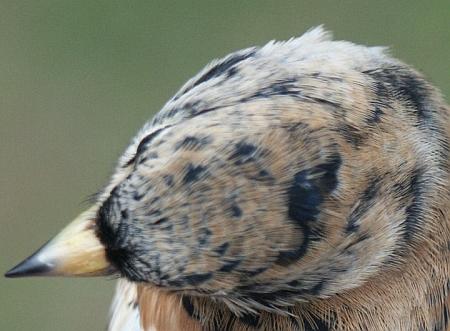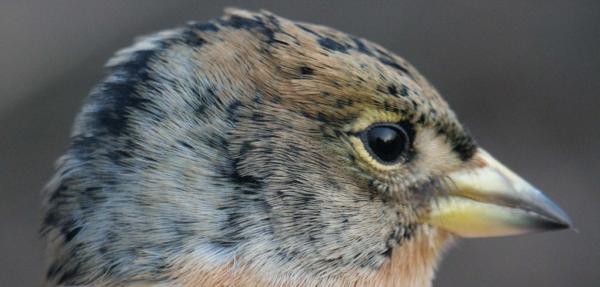Brambling and Chaffinch heads (25 April 2004)
Substantial numbers of Bramblings Fringilla montifringilla have been present since late March at Woolston, attracted to the seed provided at the feeding stations, and 50 were ringed in the first three weeks of April 2004. This is not a great total compared to many other sites, but is outstanding in the context of the total of 30 in the last 23 years of ringing at Woolston!
With a breeding range extending well into the Arctic Circle in Scandinavia, Bramblings are in no hurry to migrate back north, and catching birds this late in the season has given a good opportunity to admire their breeding plumage. Brambling is one of the classic species to acquire its nuptial head coloration by abrasion, the buff tip to each feather wearing away during winter. The following images show this effect on the heads of four different male Bramblings. Two birds from Woolston, April 2004, are on the left (photographs provided by Michael Miles), and on the right are two images posted previously of birds caught in November 2003 during the ringing course at West Burton.
%20M%20head%20(369%20x%20279).jpg)

%20(5M)%20dark%20head%20(cropped)%20(368%20x%20200).jpg)

Even in this state of plumage, these Bramblings are not in full breeding condition, as their bills have not yet turned black - a sight seldom seen in Britain. As well as the change in appearance of their feathers, finches especially show a deepening of the bill colour as the breeding hormones have an effect. This is shown quite dramatically in the other fringilline finch, Chaffinch Fringilla coelebs. The photographs below show a male ringed in Cheshire in April 2004, with an intense blue bill, compared to one caught in February 2003, posted previously.
%20head%20side%20(600%20x%20310).jpg)
%20head%20&%20bill%20(582%20x%20408).jpg)
.jpg)
Although not as noticeable, the bill colour of female Chaffinches also deepens as they approach the breeding season, from the yellowish colour typical of winter to a bluish hue, similar to, but not as intense as, that of the males.
%20head%20&%20bill%20(600%20x%20414).jpg)
Naturalists have been fascinated by finches' beaks ever since Darwin visited the Galapagos Islands in 1835. The bills of Bramblings are somewhat deeper than those of Chaffinches, with sharper edges - as ringers will testify - adaptations which especially fit them to cutting open the tough seed-cases of beech mast. Bramblings almost completely depend on beech unless they find suitable artificial food, and there was a notably poor crop of mast (beech seed) in Cheshire and Merseyside in autumn 2003. Indeed, this could well apply more widely as the BTO Migration Watch has received more than double the number of reports of Bramblings from March to mid-April in 2004 compared to the same period in 2003 or 2002.
The older members of Merseyside Ringing Group will fondly remember 1981, when we caught over 2,600 Bramblings in six weeks at a variety of sites where they were feeding under beech trees, and at their roost in rhododendrons in the grounds of Speke Hall. Some of the results from our work were described by me, Dave Cross and Rob Cockbain in ‘The Brambling invasion of Merseyside - 1981’, BTO News 114 (1981) 9.
David Norman.